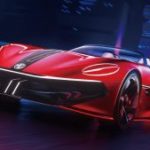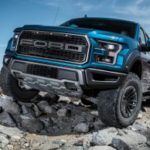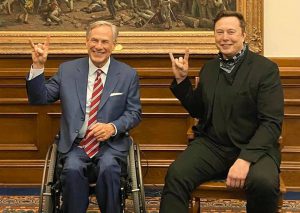
In case you were wondering if Texas or Oklahoma was the site for the new Gigafactory, that’s Gov. Greg Abbott of Texas on the left.
Things are coming up roses for Tesla these days – yellow roses – as the California-based EV maker announced it will build its next Gigafactory on a 2,000-acre plot of land just outside Austin, Texas.
Tesla CEO Elon Musk revealed the choice – Tulsa, Oklahoma was the other finalist – during the company’s second quarter earnings call. He said the site, which is on the banks of the Colorado River, would be an “ecological paradise” with a hiking and biking trail open to the public, should open sometime next year.
The plant, dubbed GigaTexas, will build a variety of vehicles, including the new Cybertruck and the Tesla semi. It will also handle Model 3 and Model Y production for the eastern half of North America. He also noted that Tulsa could still be in line for a future factory. After announcement, Musk was quick to point out the company will still grow in California.
(Tesla reports $104M Q2 profit; fourth consecutive quarter of profits.)
“We expect California to do Model X and S for worldwide consumption, and 3 and Y for the western half of North America. We also think the Tesla Roadster … would make sense in California. I think this is a nice split between Texas and California.”
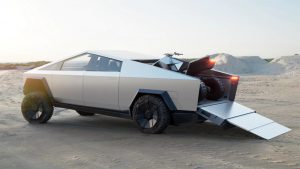
Tesla’s Cybertruck is one of four products that the company will build at GigaTexas once it’s complete.
In addition to what is going to get built where in the U.S., Musk addressed potential future products and how they fit into the company’s plans.
“It would be reasonable to assume we’d make a compact vehicle of some kind, and probably a high capacity vehicle of some kind,” he said. “These are likely things at some point. I do think there’s a long way to go with 3 and Y, Cybertruck and semi. There’s a long way to go with those. I think we’ll do the obvious things.”
While future product is critical to the company’s long-term growth, Musk says he’s got his eyes on a short-term prize: full-self driving. The CEO has long predicted that (insert year here) will be when FSD will be available in vehicles.
However, after years of missed deadlines, the company may be on track to meet his latest goal of having it available sometime this year. He called it the “most important thing” on his very full agenda, adding “everything else is pretty small by comparison.”
(Texas offers Tesla $80M in incentives for new gigafactory.)
Musk has been selling the FSD to buyers for several years now but increasing the price for the dormant technology during the past few years, starting at $5,000 to add it and now it sits at $8,000 and it’s going to get pricier as it gets closer to launch. However, there’s a good reason to charge so much money for the technology, Musk believes, as you’ll get what you pay for — and then some.
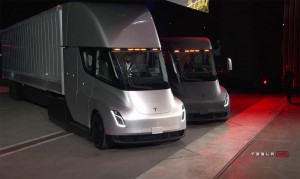
Tesla is getting ready to produce its first heavy-duty model, the all-electric Semi. It, too, will be built at the new plant in Texas.
“I think the upgrading of the fleet to full-self driving, essentially with an over-the-air software update, I mean may go down as the biggest asset value increase in history as a step change,” he said. “Overnight … you’d have like, I don’t know, a few million cars suddenly becoming five times more valuable.”
Those vehicles also become an even bigger revenue stream for Musk and Tesla as then he can begin to sell access for services, like shopping, games, movies, etc. that could be used by drivers as they allow their vehicle to drive them to their destination.
In fact, Musk is using an advanced test version of the technology now and says he can drive from his home to the office without intervention. While he wouldn’t commit to it being ready this year, he suggested he thought it would be, then it would be a matter of governmental approvals.
(CEO Musk sees big growth coming soon for Tesla.)
